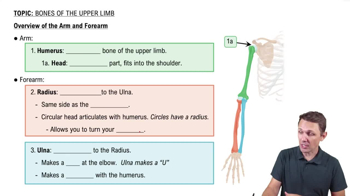Which of the following portions of the scapula articulates with the clavicle?
a. Coracoid process
b. Acromion
c. Spine
d. Glenoid cavity
 Verified step by step guidance
Verified step by step guidance Verified video answer for a similar problem:
Verified video answer for a similar problem:



 5:3m
5:3mMaster Overview of the Arm and Forearm with a bite sized video explanation from Bruce Bryan
Start learning